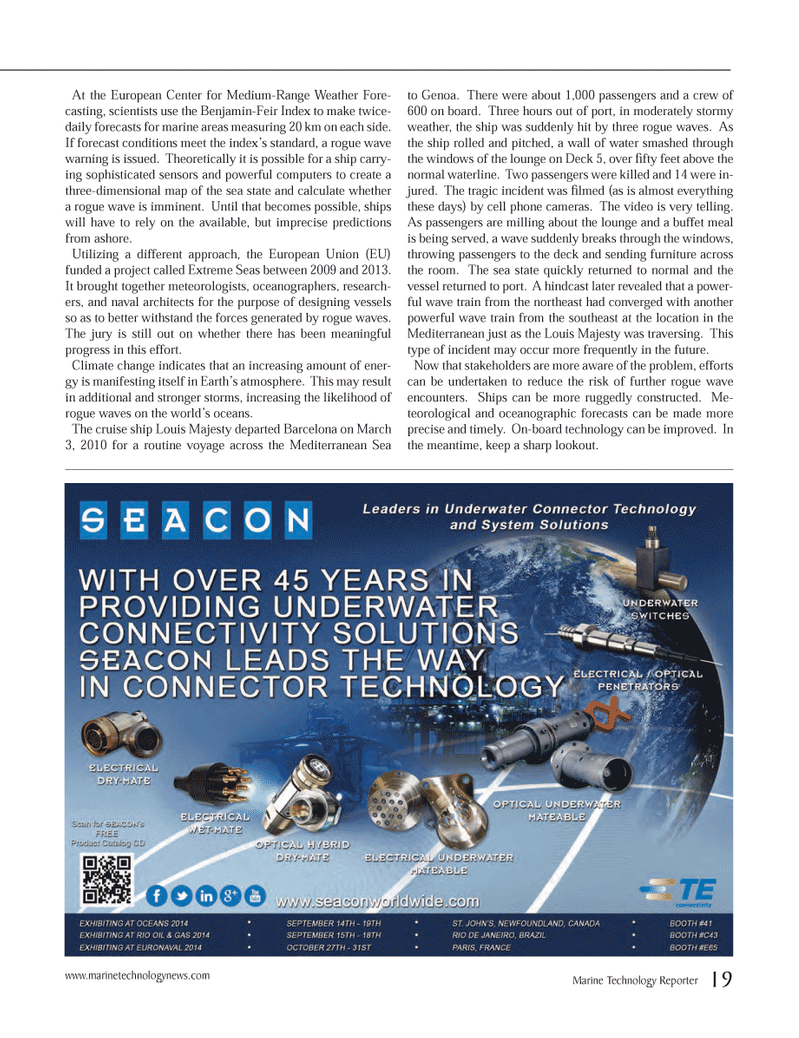
Page 19: of Marine Technology Magazine (September 2014)
Ocean Observation: Gliders, Buoys & Sub-Surface Networks
Read this page in Pdf, Flash or Html5 edition of September 2014 Marine Technology Magazine
At the European Center for Medium-Range Weather Fore- casting, scientists use the Benjamin-Feir Index to make twice- daily forecasts for marine areas measuring 20 km on each side.
If forecast conditions meet the index’s standard, a rogue wave warning is issued. Theoretically it is possible for a ship carry- ing sophisticated sensors and powerful computers to create a three-dimensional map of the sea state and calculate whether a rogue wave is imminent. Until that becomes possible, ships will have to rely on the available, but imprecise predictions from ashore.
Utilizing a different approach, the European Union (EU) funded a project called Extreme Seas between 2009 and 2013.
It brought together meteorologists, oceanographers, research- ers, and naval architects for the purpose of designing vessels so as to better withstand the forces generated by rogue waves.
The jury is still out on whether there has been meaningful progress in this effort.
Climate change indicates that an increasing amount of ener- gy is manifesting itself in Earth’s atmosphere. This may result in additional and stronger storms, increasing the likelihood of rogue waves on the world’s oceans.
The cruise ship Louis Majesty departed Barcelona on March 3, 2010 for a routine voyage across the Mediterranean Sea to Genoa. There were about 1,000 passengers and a crew of 600 on board. Three hours out of port, in moderately stormy weather, the ship was suddenly hit by three rogue waves. As the ship rolled and pitched, a wall of water smashed through the windows of the lounge on Deck 5, over fi fty feet above the normal waterline. Two passengers were killed and 14 were in- jured. The tragic incident was fi lmed (as is almost everything these days) by cell phone cameras. The video is very telling.
As passengers are milling about the lounge and a buffet meal is being served, a wave suddenly breaks through the windows, throwing passengers to the deck and sending furniture across the room. The sea state quickly returned to normal and the vessel returned to port. A hindcast later revealed that a power- ful wave train from the northeast had converged with another powerful wave train from the southeast at the location in the
Mediterranean just as the Louis Majesty was traversing. This type of incident may occur more frequently in the future.
Now that stakeholders are more aware of the problem, efforts can be undertaken to reduce the risk of further rogue wave encounters. Ships can be more ruggedly constructed. Me- teorological and oceanographic forecasts can be made more precise and timely. On-board technology can be improved. In the meantime, keep a sharp lookout.
Marine Technology Reporter 19 www.marinetechnologynews.com
MTR #7 (18-33).indd 19 8/26/2014 11:23:50 AM

 18
18

 20
20
